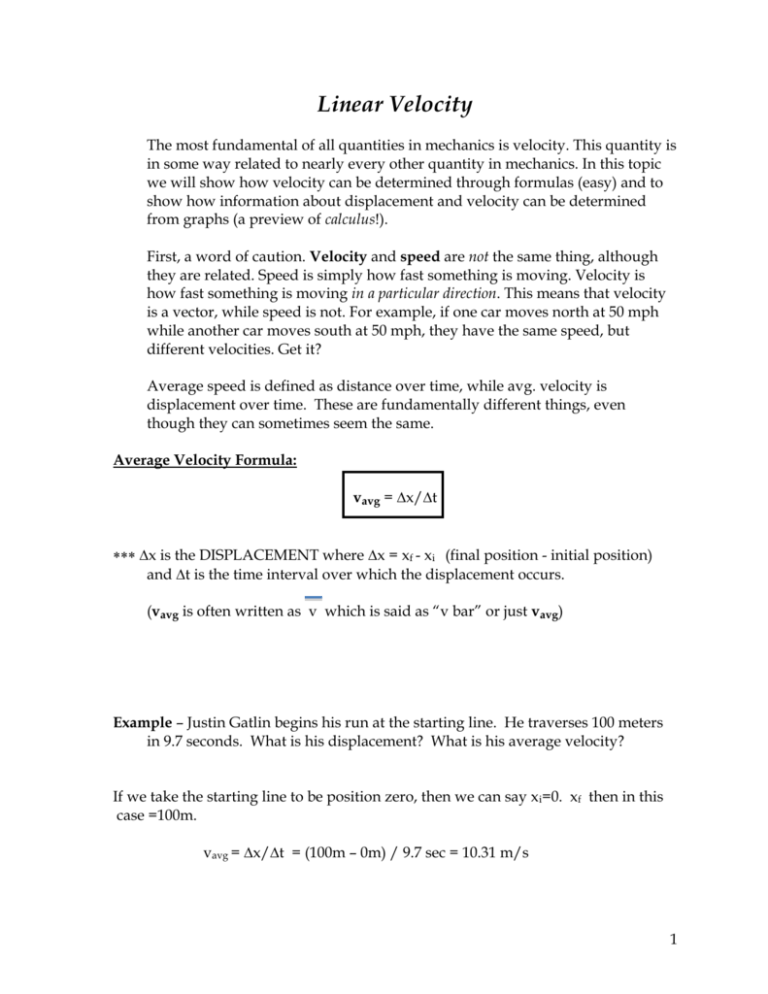Linear Velocity Packet
advertisement

Linear Velocity The most fundamental of all quantities in mechanics is velocity. This quantity is in some way related to nearly every other quantity in mechanics. In this topic we will show how velocity can be determined through formulas (easy) and to show how information about displacement and velocity can be determined from graphs (a preview of calculus!). First, a word of caution. Velocity and speed are not the same thing, although they are related. Speed is simply how fast something is moving. Velocity is how fast something is moving in a particular direction. This means that velocity is a vector, while speed is not. For example, if one car moves north at 50 mph while another car moves south at 50 mph, they have the same speed, but different velocities. Get it? Average speed is defined as distance over time, while avg. velocity is displacement over time. These are fundamentally different things, even though they can sometimes seem the same. Average Velocity Formula: vavg = x/t x is the DISPLACEMENT where x = xf - xi (final position - initial position) and t is the time interval over which the displacement occurs. (vavg is often written as v which is said as “v bar” or just vavg) Example – Justin Gatlin begins his run at the starting line. He traverses 100 meters in 9.7 seconds. What is his displacement? What is his average velocity? If we take the starting line to be position zero, then we can say xi=0. xf then in this case =100m. vavg = x/t = (100m – 0m) / 9.7 sec = 10.31 m/s 1 Average Speed & Velocity Problems 1. Angelina can jog 3200 meters in 16 minutes. How far can she go in one hour? (12,000 m) 2. If Eugene travels at an average velocity of 26 m/s and displaces 4200 m during his trip, for how long was he driving? (161.5 s) 3. Kayla swims 1000 meters in 15 minutes, then swims at 50 m/min for 20 minutes, and then swims at 40 m/min over a distance of 1500 meters. What is her overall average speed? (48.3 m/min) 4. Jacob rides his bicycle 8 miles at 25 mph, then goes 40 mph for 10 minutes, and then rides for 12 miles at 20 mph. What is his average speed overall? (24.5 mph) 5. Spender’s workout consists of running 3 miles at 11 mph, then running at 6 mph for 20 minutes, and then running 2 miles for 15 minutes. What is his average speed for the whole workout? (8.2 mph) 6. Elyssa and Brian are going to a party near Flemington. They travel at 50 mph for 10 miles, stop for 15 minutes (for a pee break, they have been drinking road sodas on the way), and then continue at 60 mph for 20 miles. Find their average velocity for the entire trip. (38.3 mph) 2 7.* Garrett is driving to work. His commute is 100 km. If the first half of the distance is driven at 50 km/h, and the second half is driven at 100 km/h, what’s his average speed? Average velocity? (67 km/h) not a typo! 8.* Billy starts off from his house to baseball practice. He walks at 2 m/s for 5 minutes then realizes he left his glove at home. He jogs home at 5.5 m/s, takes a minute to find his glove when he arrives, then sprints at 7 m/s back to practice, which takes 12 more minutes. Find his average speed and velocity for the trip. (5.25 m/s and 4.24 m/s) 3 Average Velocity & Position vs Time Graphs : Average velocity can also be found using position vs time graphs. The method for doing this is very simple. Just draw a line connecting the initial and final points, on the graph, of the time interval for which the average velocity is to be found. The slope of this line, as you should know by now, will yield the average velocity. Example Use the graph shown below to determine the average velocity for the interval t = 2 sec to t = 8 sec. Solution The line that connects the two points corresponding to the given time interval contains the coordinates (2,4) and (8,10). Applying the slope formula yields: vavg = x/t = (10 - 4)/(8 - 2) = +1 m/sec x (m) 10 x 8 6 4 x 2 1 2 3 4 5 6 7 8 9 10 t (sec) 4 Instantaneous Velocity : Instantaneous velocity is just that... the velocity at a given instant. In other words, the velocity when no time passes. So, we can’t use the formula for average velocity since the t = 0. There is, however, a way to find vinst by using a x vs t graph. Here’s how: vinst = the slope of the line that the point is on! (for x vs. t graphs only) Why does this work? Because the tangent has the same slope as the graph has at that instant. Since the slope = x/t, then it represents the velocity!!! We use the tangent because its slope can be measured a lot more easily than the slope of the impossibly small section of the graph that contains the instant in question. This idea is the foundation for ‘derivatives’ in calculus. 8 x (m) 6 x 4 2 t 1 2 3 4 5 d vs t graph 6 t (sec) a closer look at t = 3 sec 5 Finding vinst : use the slope formula and plug in the coordinates of the point you are looking at and the point where the tangent line to the point crosses an axis (either one!). In the example shown below, the instantaneous velocity at time 3 sec, aka v3, is determined using the method discussed above. this ‘d’ should be ‘x’ d (m) 7 v3 = (4-0)/(3-7) = -1 m/sec 6 5 4 3 2 1 t (sec) 1 2 3 4 5 6 7 8 In the example above, we are finding the slope between the point on the line and this point. But remember, any two points on a line can be used to find the slope. Select ones that seem the simplest to you. 6 Position vs Time Graph Problems x (m) 12 10 8 6 4 2 t (sec) 1 2 3 4 5 6 7 8 9 10 1. Using the graph shown above, find : a. the average speed between t = 2 sec and t = 5 sec b. the average v and avg. speed between t = 1 sec and t = 8 sec c. the instantaneous speed at t = 2, 4, 6, and 8 sec 2. Use the graph above to explain when the motion is a. fastest b. stopped c in the negative direction 7 x (m) 10 8 6 4 2 t (sec) 1 3. 2 3 4 5 6 7 8 9 10 Using the graph shown above, find ; a. the average v and avg. speed between t = 1 sec and t = 5 sec (½ m/s, 3/2 m/s) b. the average v and avg. speed between t = 3 sec and t = 9 sec c. the instantaneous v at t = 2, 4, and 8 sec 4. (2 m/s, 2 m/s, 8/3 m/s) Explain your answers to the following questions concerning the graph above : a. When is the motion constant? 8 b. When is the motion slowest? c. Is the motion always in the same direction? d. How many times does the motion change direction? 9 Velocity vs Time Graphs Finding Displacement: Since we’ve been able to find out information about velocity from examining displacement vs time graphs, its probably not too surprising that the reverse is also true...we can use velocity vs time graphs to find out information about displacement. Here’s how: displacement = the area “between” the v vs t graph and the time axis Why does this work? Because when you find the area “beneath” the v vs t graph, you are, in effect, multiplying vavg by time. (See Mr. E’s convincing ipad lecture segments!) velocity x time is, of course, displacement!!! Example - Use the graph shown below to find the displacements for the intervals : (a) t = 0 sec to t = 4 sec (45 m) (b) t = 3 sec to t = 7 sec (65 m) (c) t = 5 sec to t = 10 sec (5 m) v (m/s) 20 10 t (sec) 1 2 3 4 5 6 7 8 9 10 -10 10 Velocity vs Time Graph Problems v (m/s) 20 10 t (sec) 1 2 3 4 5 6 7 -10 1. Using the v vs t graph above, find displacements for (a) t = 0 to t = 4 sec (45 m) (b) t = 3 to t = 7 sec (5 m) 11 2. Based on the graph above, explain the times at which the speed is (a) constant (b) increasing (c) in the (-) direction v (m/s) 20 10 t (sec) 1 2 3 4 5 6 7 8 -10 -20 3. Based on the v vs t graph shown above, find the displacements for (a) t = 1 sec to t = 5 sec (0 m) (b) t = 2 sec to t = 7 sec (-55 m) 12 4. Refer to the previous v vs t graph to give reasons for the following: (a) Is the final displacement for the entire motion (+) or (-)? (b) Describe the motion between t = 2 sec and t = 4 sec (c) During which time intervals is s slow down happening? 13 Homework Problems 1. Given the x vs t graph shown below, find the following, and give reasons when appropriate: (a) vinst at t = 4 sec and t = 8 sec X (m) 10 8 (b) when the motion is constant (c) when the motion is negative 6 4 2 (d) when the motion is fastest t (sec) (e) when the motion turns around 2 4 6 8 10 (f) when the motion stops 14 2. Given the v vs t graph shown below, find the following and give reasons when appropriate: (a) the displacement from t = 2 sec to t = 7 sec (-60 m) v (m/s) 20 (b) when the motion is constant 10 t (sec) (c) when the motion is negative (d) when the motion is fastest (e) when the motion turns around -10 1 2 3 4 5 6 7 8 9 10 -20 (f) is the final displacement (+) or (-)? 15 Reference : Interpreting the Shapes of Motion Graphs Description of Motion v vs t graph d vs t graph Speeding up (+) direction Constant speed (+) direction Slowing down (+) direction Speeding up (-) direction Constant speed (-) direction Slowing down (-) direction Turning around Graph crosses peaks/valleys the time axis (+) direction (-) direction Graph is in the 1st (+) or 4th (-) quadrant Slope is (+) Slope is (-) fast (-) direction slow Steepest slope (fastest) Flattest slope (slowest) constant speed Furthest (fastest) or Closest (slowest) to time axis Parallel to axis (constant) stopped On the axis (stopped) Horizontal line Straight line 16









